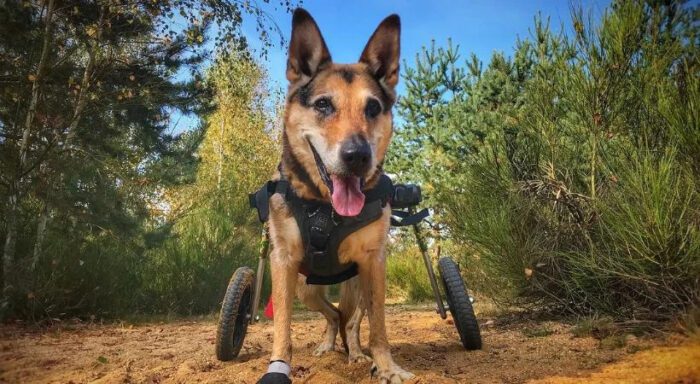Degenerative myelopathy (DM) is a progressive disease of the spinal cord that affects older German shepherds. It causes hind limb weakness and paralysis that starts in the back legs and progresses forward. DM is incurable and will eventually result in complete paralysis. However, with supportive care and management, dogs can continue to have a good quality of life for months to years after diagnosis. In this article we talk about Degenerative Myelopathy In German Shepherd and How to Detect and Manage.
Table of Contents
Early Signs of Degenerative Myelopathy

The first subtle signs of DM are usually a slight unsteadiness or wobbliness when walking and slight dragging of the back feet/toes. Owners may notice worn down toenails on the dog’s rear paws from the dragging. Early on, symptoms can be intermittent and come and go, making them easy to overlook. Over time, the weakness and lack of coordination in the hind legs progresses. Other early signs of DM include:
- Reluctance to jump up or go upstairs
- Stumbling or tripping more often
- Crossing over the back legs when walking
- Difficulty standing up after lying down
These early symptoms are gradual in onset and can look similar to arthritis or other orthopedic issues. That’s why it’s important to have a vet examine your senior German shepherd if you notice any wobbliness or change in their gait. Catching DM early allows you to better manage it.
Getting a Degenerative Myelopathy Diagnosis
There is no specific test for DM. Your veterinarian will likely run blood work and possibly radiographs (x-rays) of the spine to rule out other conditions first. A neurologic exam will also be performed checking your dog’s reflexes, sensation, and nerve function. Your vet may refer you to a veterinary neurologist for advanced imaging of the spinal cord. An MRI or CT scan can sometimes detect signs of DM. But even with imaging, the diagnosis is still presumptive. The only way to definitively diagnose DM is through examination of the spinal cord during an autopsy after death.
For owners, it can be frustrating to hear it’s a “presumed” diagnosis. But the treatment and management of DM is the same regardless. Having a neurologist confirm the likely diagnosis gives owners confidence they are providing the appropriate care for their dog. While no cure exists, the right management can sustain your German shepherd’s quality of life despite the progressive paralysis.
Caring for a German Shepherd with Degenerative Myelopathy
The progression of DM cannot be reversed or stopped, but providing supportive care is vital. With treatment, dogs can plateau at some stages of the disease without progressing for a time. Physical therapy, mobility aids, preventing pressure sores, monitoring urine function, and keeping a safe environment are all critical to ensure your German shepherd stays happy and comfortable despite increasing paralysis.
Here are some tips for caring for a German shepherd diagnosed with DM:
Physical Therapy: Physical rehabilitation with a canine therapist can help strengthen muscles, maintain range of motion in the limbs, and slow loss of coordination. Hydrotherapy in a dog pool is especially helpful. Stretching, massage, assisted walking on treadmills or underwater, and other modalities can be incorporated into therapy sessions. Your neurologist or vet can provide a referral for physical rehab.
Mobility Aids: Braces, harnesses, slings, and wheeled carts can help dogs remain upright and mobile as DM progresses. Custom dog wheelchairs support the rear while allowing the front legs to bear some weight and continue walking. Harnesses with handles assist with standing, stability and help the dog walk. Consult with your physical therapist to determine which mobility aids would benefit your German shepherd.
Pressure Sore Prevention: Check your dog’s limbs and joints daily for signs of sores from pressure points or dragging. Pad bony areas to prevent calluses and sores. Gently reposition your dog every few hours to shift weight distribution. Avoid letting them lie in one place too long. Soft bedding is essential. Keep the coat trimmed around the rear and tail. Clean any wounds thoroughly and seek veterinary care if they appear infected.
Bladder/Bowel Function: Monitor your dog’s bathroom habits. Feel the bladder for fullness if they have trouble urinating or seem uncomfortable. Express the bladder if needed. You may need to help support posture for bowel movements. Incontinence pads and diapers can help contain accidents. Report abnormal urine or stools to your vet as it could signal a urinary tract or bowel infection.
Safe Environment: Remove tripping hazards and install dog ramps to make your home safer as your German shepherd loses mobility. Block off stairs if ascending/descending becomes difficult. Provide non slip surfaces for footing. Clear pathways through the home for easier navigation. Lift in/out of vehicles, beds, or high furniture. Don’t force them into uncomfortable positions just to keep them near you. Carry smaller dogs when needed.
Quality of Life Assessment
Despite best efforts, DM will continue affecting nerve communication between the brain and limbs. Euthanasia is inevitable once paralysis and immobility severely impact quality of life. Cherish the good days when your German shepherd still eagerly greets you and enjoys favorite activities. Monitor bad days for signs of pain, anxiety, frustration, depression or loss of spark/appetite signaling decline in condition. Discuss guidelines for euthanasia decisions with your vet so you recognize when the time comes to spare your dog further suffering. Saying goodbye is incredibly hard, but finding the grace in that last act of love honors your loyal companion.
Living with Degenerative Myelopathy
Coping with a progressive condition like DM in your beloved German shepherd is difficult emotionally. Letting go of hopes for a cure and focusing on each good day left together brings peace. Celebrate small mobility milestones post-diagnosis and savor every cuddle. Capture paw prints and save fur clippings to create lasting keepsakes. Ask your vet to make a veterinary hospice referral for extra TLC in-home during the final stage. Connect with other DM dog owners online for comfort and advice. Most importantly, simply love your dog through each phase — that unwavering devotion means everything to them.
Degenerative myelopathy is a challenging disease, but educating yourself on what to expect and how to best manage it will help you assist your German shepherd in living their most fulfilling life in spite of declining mobility. Early detection, maintaining strength/coordination as long as possible, and adapting their environment for safety/accessibility allows them to stay happy in the only place they want to be — by your side. Shower them with patience and affection through the good days and difficult ones ahead. I sincerely hope you find this “Degenerative Myelopathy In German Shepherd-How to Detect and Manage” article helpful.
🔗 More SuhDog Resources

Dr. Amanda Davis is the lead writer for SuhDog.com and holds a Master’s degree in Animal Behavior. With over 8 years of experience, she specializes in canine behavior and training. Dr. Davis is a trusted voice in the pet care community, contributing to various pet magazines and speaking at industry conferences. Follow her on Instagram: @suh_dog_.

